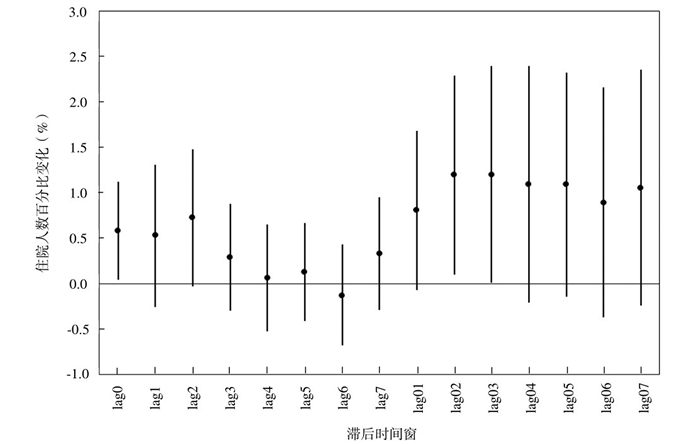Association of ambient coarse particulate matter with hospital admissions, related expenditures and stays for depression in China: a multicity study
-
摘要:
目的 基于中国城镇职工基本医疗保险和城镇居民基本医疗保险数据库,分析大气粗颗粒物(coarse particulate matter, PM2.5-10)短期暴露与中国部分城市人群抑郁症住院人数、费用与天数的关联。 方法 基于2013―2017年中国56个地级及以上城市大气PM2.5-10数据及抑郁症住院信息,进行两阶段时间序列分析。使用广义相加模型控制星期几效应、节假日效应、长期趋势、气象因素等混杂因素后,分别分析各城市大气PM2.5-10短期暴露对抑郁症住院人数影响,并采用随机效应模型综合不同城市结果,进而计算住院人数、住院费用和住院天数的归因数及归因百分比。 结果 研究共纳入56个城市82 708例抑郁症住院患者信息。大气PM2.5-10短期暴露与抑郁症住院人数、费用与天数之间存在正向关联。在lag0、lag02和lag03时间窗上,大气PM2.5-10短期暴露浓度每升高10 μg/m3,抑郁症住院人数分别增加0.58%(95% CI: 0.04%~1.12%)、1.20%(95% CI: 0.10%~2.29%)和1.20%(95% CI: 0.01%~2.39%)。其中在lag03时间窗,住院人数、费用和天数归因于PM2.5-10短期暴露的百分比达到最大,分别为4.14%(95% CI: 0.04%~8.03%)、3.67%(95% CI: 0.03%~7.14%)和3.89%(95% CI: 0.04%~7.54%);平均每个患者因PM2.5-10短期暴露导致的归因住院费用和天数分别为483.77(95% CI: 4.49~940.63)元和1.03(95% CI: 0.01~1.99) d。 结论 短期暴露于大气粗颗粒物与中国城市人群抑郁症住院人数、费用和天数的增加有关。 Abstract:Objective Based on China's urban employee basic medical insurance and urban residents' basic medical insurance database, this study aims to investigate the associations between short-term exposure to ambient coarse particulate matter (PM2.5-10) and risk of hospital admissions, related expenditures and stays (counted as days in hospital) for depression. Methods A two-stage time-series study was conducted using the daily data in ambient PM2.5-10 and hospital admissions for depression in 56 prefecture-level or above cities in China from 2013 to 2017. The generalized additive model (GAM) with adjustment for day-of-week effect, holiday effect, secular trend, and meteorological variables was used to investigate the city-specific associations between short-term exposure to PM2.5-10 and risk of hospital admissions for depression, and a random-effects model was used to pool the city-specific associations to generate an overall association over different cities. Attributable numbers and fractions of hospital admissions, related expenditures and stays associated with short-term exposure to ambient PM2.5-10 were also calculated based on the results of the two-stage time-series analyses. Results A total of 82 708 hospital admissions for depression were identified in the urban medical insurance schemes in 56 Chinese cities during the study period. Short-term exposure to ambient PM2.5-10 was associated with increased hospital admissions, related expenditures and stays. For each 10 μg/m3 increase in lag0, lag02, and lag03, there were significant increases of 0.58% (95% CI: 0.04%-1.12%), 1.20% (95% CI: 0.10%-2.29%) and 1.20% (95% CI: 0.01%-2.39%) in hospital admissions for depression, respectively. The attributable fractions of hospital admissions, related expenditures and stays associated with ambient PM2.5-10 reached maximum values at lag03, and were 4.14% (95% CI: 0.04%-8.03%), 3.67% (95% CI: 0.03%-7.14%) and 3.89% (95% CI: 0.04%-7.54%), respectively; and the average hospitalization expenditure and stay per patient due to short-term exposure to PM2.5-10 were 483.77 (95% CI: 4.49-940.63) yuan and 1.03 (95% CI: 0.01-1.99) d, respectively. Conclusion Short-term exposure to ambient PM2.5-10 is associated with increased risk of hospital admissions, expenditures and stays for depression in the general urban population in China. -
Key words:
- Air pollution /
- Coarse particulate matter /
- Depression /
- Hospital admissions /
- Expenditures /
- Association
-
表 1 2013―2017年中国56个城市抑郁症住院人数、费用和天数的分布[n(%)]
Table 1. The distribution of the number of hospitalizations, expenditures and days of depression in 56 cities in China from 2013 to 2017 [n(%)]
分类 住院人数(人) 住院费用(万元) 住院天数(万天) 地理区域 北方城市 41 378(50.03) 54 899.23(50.35) 94.67(43.48) 南方城市 41 330(49.97) 54 134.90(49.65) 123.04(56.52) 性别a 男 25 084(30.33) 32 267.81(29.59) 73.32(33.68) 女 41 890(50.65) 55 930.85(51.30) 113.73(52.24) 年龄(岁) a 0~<19 1 094(1.32) 1 699.79(1.56) 5.86(2.69) 19~<40 10 609(12.83) 17 680.66(16.22) 38.33(17.61) 40~<65 39 692(47.99) 47 542.80(43.60) 97.36(44.72) ≥65 15 579(18.84) 21 275.42(19.51) 45.49(20.89) 季节 温暖季节 41 578(50.27) 58 670.82(53.81) 105.96(48.67) 寒冷季节 41 130(49.73) 50 363.31(46.19) 111.75(51.33) 合计 82 708(100.00) 109 034.13(100.00) 217.71(100.00) 注:a性别、年龄分组住院数据统计去除了缺失分组信息的个体 表 2 2013―2017年中国56个城市日均大气PM2.5-10及气象因素水平分布
Table 2. Distribution of average daily atmospheric PM2.5-10 and meteorological factors in 56 cities in China from 2013 to 2017
气象因素 平均值 标准差 最小值 中位数 最大值 Q a PM2.5-10日均浓度(μg/m3) 北方城市 49.65 32.34 0.00 43.22 726.20 39.22 南方城市 27.44 19.68 0.00 23.15 1259.50 19.53 总体 38.35 28.88 0.00 30.63 1259.50 31.96 日均气温(℃) 北方城市 11.46 11.69 -28.90 12.90 35.30 19.30 南方城市 18.14 8.32 -6.60 19.20 36.10 13.60 总体 14.92 10.62 -28.90 16.50 36.10 15.90 日均相对湿度(%) 北方城市 62.72 18.08 7.00 64.00 100.00 28.00 南方城市 75.38 13.86 17.00 77.00 100.00 20.00 总体 69.28 17.24 7.00 71.00 100.00 24.00 注:a即四分位数间距(inter-quartile range)。 表 3 双污染物模型中不同滞后时间窗大气PM2.5-10浓度每升高10 μg/m3对应的抑郁症住院人数的百分比变化及其95% CI
Table 3. The percentage change and 95% CI of the number of hospitalized depression patients corresponding to each increase of 10 μg/m3 of atmospheric PM2.5-10 concentration in the dual-pollutant model with different lag time windows
滞后时间窗 单污染物模型(%) 调整PM2.5(%) 调整CO(%) 调整SO2(%) 调整O3(%) 调整NO2(%) lag0 0.58(0.04~1.12) 0.41(-0.03~0.86) 0.35(-0.13~0.83) 0.48(-0.06~1.02) 0.39(-0.06~0.84) 0.29(-0.21~0.78) lag02 1.20(0.10~2.29) 0.77(0.05~1.49) 0.78(-0.02~1.59) 0.76(-0.09~1.61) 0.75(0.05~1.46) 0.54(-0.23~1.31) lag03 1.20(0.01~2.39) 0.82(0.07~1.58) 0.86(0.03~1.69) 0.78(-0.09~1.65) 0.82(0.08~1.56) 0.62(-0.16~1.40) 表 4 不同滞后时间窗与大气PM2.5-10相关抑郁症住院人数、费用和天数的归因数、归因百分比及其95% CI
Table 4. The attributable number, attribution percentage and 95% CI of the number of hospitalizations, expenditures and days of depression related to atmospheric PM2.5-10 with different lag time windows
结果类型 住院人数(人) 住院费用(万元) 住院天数(万天) 平均住院费用(元) 平均住院天数(d) lag0 归因数 1 680(117~3 206) 1 962.83(136.88~3 749.18) 4.17(0.29~7.96) 237.32(16.55~453.30) 0.50(0.04~0.96) 归因百分比(%) 2.03(0.14~3.88) 1.80(0.13~3.44) 1.91(0.13~3.65) lag02 归因数 3 412(302~6 378) 3 991.22(353.01~7 472.64) 8.47(0.75~15.82) 482.57(42.68~903.74) 1.02(0.09~1.91) 归因百分比(%) 4.13(0.37~7.71) 3.66(0.32~6.85) 3.88(0.34~7.25) lag03 归因数 3 421(32~6 640) 4 001.16(37.13~7 779.78) 8.49(0.08~16.47) 483.77(4.49~940.63) 1.03(0.01~1.99) 归因百分比(%) 4.14(0.04~8.03) 3.67(0.03~7.14) 3.89(0.04~7.54) 表 5 不同亚组大气PM2.5-10浓度每升高10 μg/m3对应的抑郁症住院人数的百分比变化及其95% CI(%)
Table 5. Percentage change and 95% CI of the number of hospitalized depression patients corresponding to each increase of atmospheric PM2.5-10 concentration by 10 μg/m3 in different subgroups (%)
变量 Lag02 Lag03 地理区域 北方城市 0.78(-0.72~2.28) 1.00(-0.51~2.51) 南方城市 1.86(0.26~3.46) 1.49(-0.50~3.48) Z值 0.927 0.207 P值 0.335 0.649 性别 男 1.22(0.07~2.37) 1.30(0.05~2.55) 女 0.72(-0.46~1.89) 0.69(-0.61~1.98) Z值 0.361 0.450 P值 0.548 0.501 年龄(岁) 19~<40 2.74(1.31~4.17) 2.32(-0.29~4.94) 40~<65 0.90(-0.42~2.21) 1.14(-0.39~2.67) ≥65 1.44(0.09~2.79) 1.96(0.34~3.59) Z值 0.623 0.834 P值 0.172 0.661 季节 温暖季节 -0.73(-2.10~0.65) -0.26(-2.14~1.63) 寒冷季节 2.11(0.58~3.63) 1.52(-0.04~3.08) Z值 7.503 2.571 P值 0.006 0.148 表 6 大气PM2.5-10短期暴露与抑郁症住院人数关联的荟萃回归结果及其95% CI(%)
Table 6. The regression results of the the association between short-term exposure to atmospheric PM2.5-10 and the number of hospitalized depression patients and its 95% CI (%)
变量 lag02 lag03 地理区域 北方城市 -1.07(-3.33~1.19) -0.62(-3.09~1.86) 南方城市 0.00 0.00 性别 男 0.63(-1.04~2.31) 0.41(-1.49~2.31) 女 0.00 0.00 年龄(岁) 19~<40 1.30(-0.69~3.30) 0.35(-2.99~3.68) 40~<65 -0.66(-2.36~1.05) -1.00(-3.21~1.21) ≥65 0.00 0.00 季节 温暖季节 0.00 0.00 寒冷季节 2.77(0.66~4.88) 1.95(-0.48~4.38) -
[1] GBD 2019 Diseases and Injuries Collaborators. Global burden of 369 diseases and injuries in 204 countries and territories, 1990-2019: a systematic analysis for the Global Burden of Disease Study 2019[J]. Lancet, 2020, 396(10258): 1204-1222. DOI: 10.1016/S0140-6736(20)30925-9. [2] 中华人民共和国国家卫生健康委员会. 国务院新闻办公室2020年12月23日新闻发布会文字实录[EB/OL]. (2020-12-23)[2021-04-23]. http://www.nhc.gov.cn/cms-search/xxgk/getManuscriptXxgk.htm?id=bc4379ddf4324e7f86f05d31cc1c4982.National Health Commission of the People's Republic of China. Transcript of the press conference of the State Council Information Office on December 23, 2020[EB/OL]. (2020-12-23)[2021-04-23]. http://www.nhc.gov.cn/cms-search/xxgk/getManuscriptXxgk.htm?id=bc4379ddf4324e7f86f05d31cc1c4982. [3] Gu X, Guo T, Si Y, et al. Association between ambient air pollution and daily hospital admissions for depression in 75 Chinese cities[J]. Am J Psychiatry, 2020, 177(8): 735-743. DOI: 10.1176/appi.ajp.2020.19070748. [4] Szyszkowicz M, Kousha T, Kingsbury M, et al. Air pollution and emergency department visits for depression: a multicity case-crossover study[J]. Environ Health Insights, 2016, 10: 155-161. DOI: 10.4137/EHI.S40493. [5] Pun VC, Manjourides J, Suh H. Association of ambient air pollution with depressive and anxiety symptoms in older adults: results from the NSHAP study[J]. Environ Health Perspect, 2017, 125(3): 328-342. DOI: 10.1289/EHP494. [6] Liu Q, Wang W, Gu X, et al. Association between particulate matter air pollution and risk of depression and suicide: a systematic review and meta-analysis[J]. Environ Sci Pollut Res Int, 2021, 28(8): 9029-9049. DOI: 10.1007/s11356-021-12357-3. [7] Chen R, Yin P, Meng X, et al. Associations between coarse particulate matter air pollution and cause-specific mortality: a nationwide analysis in 272 Chinese cities[J]. Environ Health Perspect, 2019, 127(1): 17008. DOI: 10.1289/EHP2711. [8] Vicedo-Cabrera AM, Sera F, Liu C, et al. Short term association between ozone and mortality: global two stage time series study in 406 locations in 20 countries[J]. BMJ, 2020, 368: m108. DOI: 10.1136/bmj.m108. [9] Tian Y, Liu H, Wu Y, et al. Association between ambient fine particulate pollution and hospital admissions for cause specific cardiovascular disease: time series study in 184 major Chinese cities[J]. BMJ, 2019, 367: l6572. DOI: 10.1136/bmj.l6572. [10] 张天嵩, 张苏贤. 如何实现Meta分析中不同亚组合并效应量的比较[J]. 中国循证医学杂志, 2017, 17(12): 1465-1470. DOI: 10.7507/1672-2531.201705103.Zhang TS, Zhang SX. How to realize the comparison of different sub combinations and effect quantities in meta-analysis[J]. Chin J Evi Med, 2017, 17(12): 1465-1470. DOI: 10.7507/1672-2531.201705103. [11] Chen C, Liu C, Chen R, et al. Ambient air pollution and daily hospital admissions for mental disorders in Shanghai, China[J]. Sci Total Environ, 2018, 613-614: 324-330. DOI: 10.1016/j.scitotenv.2017.09.098. [12] Wang F, Liu H, Li H, et al. Ambient concentrations of particulate matter and hospitalization for depression in 26 Chinese cities: a case-crossover study[J]. Environ Int, 2018, 114: 115-122. DOI: 10.1016/j.envint.2018.02.012. [13] Brook RD, Rajagopalan S, Pope CA, et al. Particulate matter air pollution and cardiovascular disease: an update to the scientific statement from the American Heart Association[J]. Circulation, 2010, 121(21): 2331-2378. DOI: 10.1161/CIR.0b013e3181dbece1. [14] Chu C, Zhang H, Cui S, et al. Ambient PM2.5 caused depressive-like responses through Nrf2/NLRP3 signaling pathway modulating inflammation[J]. J Hazard Mater, 2019, 369: 180-190. DOI: 10.1016/j.jhazmat.2019.02.026. [15] Fonken LK, Xu X, Weil ZM, et al. Air pollution impairs cognition, provokes depressive-like behaviors and alters hippocampal cytokine expression and morphology[J]. Mol Psychiatry, 2011, 16(10): 987-995, 973. DOI: 10.1038/mp.2011.76. [16] Block ML, Wu X, Pei Z, et al. Nanometer size diesel exhaust particles are selectively toxic to dopaminergic neurons: the role of microglia, phagocytosis, and NADPH oxidase[J]. FASEB J, 2004, 18(13): 1618-1620. DOI: 10.1096/fj.04-1945fje. [17] Hasler G. Pathophysiology of depression: do we have any solid evidence of interest to clinicians?[J]. World psychiatry, 2010, 9(3): 155-161. DOI: 10.1002/j.2051-5545.2010.tb00298.x. -





 下载:
下载:

